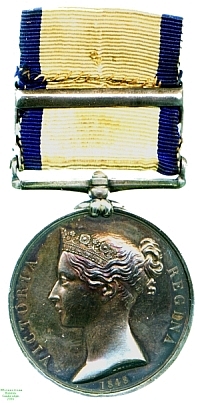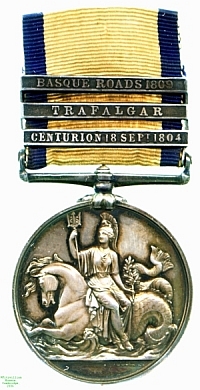
Obverse, a bust of Queen Victoria

Reverse, Britannia with a trident seated sideways on a seahorse

Obverse, a bust of Queen Victoria |

Reverse, Britannia with a trident seated sideways on a seahorse |
Just as in 1848 the extensive land campaigns of the Napoleonic Wars and the other conflicts of the pre-Victorian era were recognised by the issue of the Military General Service Medal, those serving in the Navy at the time were recognised with the Naval General Service Medal. As with the Army equivalent and the East India Company's related award, many of the battles for which the medal was awarded had been fought so long ago that few if any claimants survived.
In addition, bars were awarded for many actions whose significance and size were, despite the heroism displayed by those involved, relatively minor. The result was that many of the bars were issued in tiny numbers, with some combinations all but unique, and the medals command a very high price among collectors because of this rarity and individuality. This in turn, along with the manufacture in most cases of more bars than were eventually issued, has led to the `improvement' of many common awards where recipients' names are shared with those present at `rarer' battles. The medal also shares with the Military General Service and Army of India Medals the oddity that Queen Victoria, whose portrait they bear, was not the ruler under whom the battles for which it was awarded were fought.
The farflung interests of the British Empire even during the high point of Emperor Napoleon I's power meant that the NGSM was sometimes awarded for actions very far from the main theatres of war. The bar for Centurion 18 Sept 1804 related to an action in which Centurion, standing by to escort merchant ships to Madras, was engaged by a French commerce-raiding squadron of three ships, Atalante, Marengo & Semillante. Major Gordon reports that the French vessels crippled the outnumbered Centurion but made off without finishing her off (British Battles and Medals (Aldershot 1947), p. 55). Survivors won this bar 44 years later.
One such was Able Bodied Seaman James Cole, who went from Centurion to serve in HMS Revenge. It was in Revenge that he earnt his subsequent two bars, at Trafalgar and at the Basque Roads.
The Battle of Trafalgar is so famous as almost to need no description. By 1805 Napoleon had determined to defeat, once and for all, the British blockade that prevented the formidable fleets of France and Spain from joining their forces on the high seas, and a successful combination of the French Mediterranean Fleet and Spanish fleet in that year might have heralded the invasion of Britain but for several skirmishes preventing the allied ships meeting the French invasion fleet at Brest. Instead, the combined fleet took refuge in Cadiz and here Admiral Horatio Nelson gathered an increasing, if rather disparate, force of ships to try to engage the enemy.
Nelson's plan involved an attack in two formations to fall upon the French rearguard and cutting off these ships before starting a melée in which superior British gunnery and training (largely due to the years of blockade enforced upon the enemy) would ineluctably tell. Once out of Cadiz, the French Admiral Pierre Villeneuve changed his formation to meet the oncoming British several times and was obeyed only slowly, resulting in disorganisation, but the Franco-Spanish fleet still outnumbered Nelson's considerably. Although the first British ships to come within range of the enemy were heavily damaged in the approach that Nelson's plan required, the concentration that it brought on the Franco-Spanish centre meant that these vessels were heavily attacked before their fellows could come to their aid, and the eventual inevitable progress of the battle led to 17 French and Spanish vessels being taken by the British, and only 11 returning to Cadiz; 4 more that escaped were taken at the Battle of Cape Ortegal. Although numerous British ships were heavily damaged, none were lost; the most significant damage to the British fleet was of course the death of Nelson, shot by a sniper from the French Redoutable, shortly afterwards prevented from boarding Nelson's flagship HMS Victory by an attack from HMS Temeraire and finally taken. Nelson's death was mourned on a wide scale in Britain, and Napoleon had already abandoned his invasion plans in favour of Italian campaigns, but Nelson's victory prevented the Franco-Spanish fleets making any serious contribution to their war effort for the rest of the Napoleonic Wars. His flagship Victory is preserved at Portsmouth and is still in official commission in the Navy. Villeneuve, captured by the British, was found stabbed in his cabin having apparently committed suicide.
HMS Revenge was still in service 4 years later when she fought at the Battle of Basque Roads, more fully described elsewhere. Presumably AB Cole managed to leave naval service after this. Lester Watson purchased his medal from the London dealers Baldwin in 1928. It had previously formed part of the Payne Collection, and Payne had obtained it from a collector by the name of Whalley in 1877.